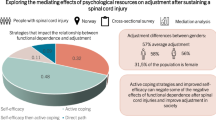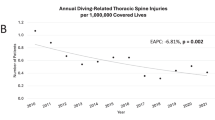Abstract
Study design
Retrospective electronic medical record review combined with a telephone interview.
Objectives
The purpose of this study was to describe the neurological and socio-professional outcomes of patients with diving injuries of the cervical spine.
Setting
A tertiary hospital and its affiliated rehabilitation hospital in South Korea.
Methods
Electronic medical records were reviewed for medical and neurological information. Telephone interviews were then conducted with questionnaire regarding specific circumstances at the time of injury and social status.
Results
A total of 33 patients with spinal cord injury (SCI) due to diving accidents were analyzed, of which 27 responded to telephone interviews. Thirty-two (97%) participants were men and 27 (81.8%) were younger than 40 years at the time of injury. The American Spinal Injury Association grade A was the most common of all grades in 16 participants (48.5%), whereas C4 was the most common neurologic level of the injury (n = 13, 39.4%). SCI due to diving accidents most commonly occurred in swimming pools in holiday lodges (n = 12, 36.4%). Five out of 13 married couples with motor complete SCI were divorced or separated after injury. Eight persons resumed work or studies after the injury, with a mean return time of 33 (24.4) months.
Conclusions
SCI resulting from a diving accident not only causes severe functional impairment but can also result in changes in marital and employment status. This study may be used as a basic source of education and awareness to prevent further SCI due to diving accidents.
Similar content being viewed by others
Log in or create a free account to read this content
Gain free access to this article, as well as selected content from this journal and more on nature.com
or
Data availability
All datasets generated or analyzed in this study are available from the corresponding authors on responsible request.
References
Van Den Berg M, Castellote JM, Mahillo-Fernandez I, de Pedro-Cuesta J. Incidence of traumatic spinal cord injury in Aragon, Spain (1972–2008). J Neurotrauma. 2011;28:469–77.
Anghelescu A. Prevention of diving-induced spinal cord injuries-preliminary results of the first Romanian mass media prophylactic educational intervention. Spinal Cord Ser Cases. 2017;3:17018.
Barss P, Djerrari H, Leduc BE, Lepage Y, Dionne CE. Risk factors and prevention for spinal cord injury from diving in swimming pools and natural sites in Quebec, Canada: a 44-year study. Accid Anal Prev. 2008;40:787–97.
Amorim EC, Vetter H, Mascarenhas LB, Gomes EG, Carvalho JB, Gomes JF, et al. Spine trauma due to diving: main features and short-term neurological outcome. Spinal Cord. 2011;49:206–10.
Shingu H, Ikata T, Katoh S, Akatsu T. Spinal cord injuries in Japan: a nationwide epidemiological survey in 1990. Paraplegia. 1994;32:3–8.
Acton PA, Farley T, Freni LW, Ilegbodu VA, Sniezek JE, Wohlleb JC, et al. Traumatic spinal cord injury in Arkansas, 1980 to 1989. Arch Phys Med Rehabil. 1993;74:1035–40.
da Paz AC, Beraldo PS, Almeida MC, Neves EG, Alves CM, Khan P, et al. Traumatic injury to the spinal cord. Prevalence in Brazilian hospitals. Paraplegia. 1992;30:636–40.
Ring IT, Berry G, Dan NG, Kwok B, Mandryk JA, North JB, et al. Epidemiology and clinical outcomes of neurotrauma in New South Wales. Aust N Z J Surg. 1986;56:557–66.
Dahlberg A, Kotila M, Leppanen P, Kautiainen H, Alaranta H. Prevalence of spinal cord injury in Helsinki. Spinal Cord. 2005;43:47–50.
Chan CW, Eng JJ, Tator CH, Krassioukov A. Spinal Cord Injury Research Evidence Team. Epidemiology of sport-related spinal cord injuries: a systematic review. J Spinal Cord Med. 2016;39:255–64.
Kluger Y, Jarosz D, Paul DB, Townsend RN, Diamond DL. Diving injuries: a preventable catastrophe. J Trauma. 1994;36:349–51.
Chiu WT, Lin HC, Lam C, Chu SF, Chiang YH, Tsai SH, et al. Review paper: epidemiology of traumatic spinal cord injury: comparisons between developed and developing countries. Asia Pac J Public Health. 2010;22:9–18.
Jazayeri SB, Beygi S, Shokraneh F, Hagen EM, Rahimi-Movaghar V. Incidence of traumatic spinal cord injury worldwide: a systematic review. Eur Spine J. 2015;24:905–18.
Park CI, Shin JC, Kim SW, Jang SH, Chung WT, Kim HJ, et al. Epidemiologic study of spinal cord injury. J Korean Acad Rehabil Med. 1999;23:267–275.
Lee JS, Kim SW, Jee SH, Kim JC, Choi JB, Cho SY, et al. Factors Affecting quality of life among spinal cord injury patients in Korea. Int Neurourol J. 2016;20:316–20.
Borius PY, Gouader I, Bousquet P, Draper L, Roux FE. Cervical spine injuries resulting from diving accidents in swimming pools: outcome of 34 patients. Eur Spine J. 2010;19:552–7.
Chan-Seng E, Perrin FE, Segnarbieux F, Lonjon N. Cervical spine injuries from diving accident: a 10-year retrospective descriptive study on 64 patients. Orthop Traumatol Surg Res. 2013;99:607–13.
Barbara-Bataller E, Mendez-Suarez JL, Aleman-Sanchez C, Sanchez-Enriquez J, Sosa-Henriquez M. [Spinal cord injuries resulting from diving accidents in the Canary Islands]. Neurocirugia. 2017;28:183–9.
Aito S, D’Andrea M, Werhagen L. Spinal cord injuries due to diving accidents. Spinal Cord. 2005;43:109–16.
Green BA, Gabrielsen MA, Hall WJ, O’Heir J. Analysis of swimming pool accidents resulting in spinal cord injury. Paraplegia. 1980;18:94–100.
Korres DS, Benetos IS, Themistocleous GS, Mavrogenis AF, Nikolakakos L, Liantis PT, et al. Diving injuries of the cervical spine in amateur divers. Spine J. 2006;6:44–9.
Vlok AJ, Petersen J, Dunn RN, Stander J. Shallow-water spinal injuries-devastating but preventable. S Afr Med J. 2010;100:682–4.
National Spinal Cord Injury Statistical Center, Facts and Figures at a Glance. Birmingham, AL: University of Alabama at Birmingham, 2017.
DeVivo MJ, Hawkins LN, Richards JS, Go BK. Outcomes of post-spinal cord injury marriages. Arch Phys Med Rehabil. 1995;76:130–8.
Jain NB, Sullivan M, Kazis LE, Tun CG, Garshick E. Factors Associated with Health-Related Quality of Life in Chronic Spinal Cord Injury. Am J Phys Med Rehabil. 2007;86:387–96. https://doi.org/10.1097/PHM.0b013e31804a7d00.
Senthilselvan A, Coonghe WVL, Beach J. Respiratory health occupation and the healthy worker effect. Occup Med. 2020;70:191–9. https://doi.org/10.1093/occmed/kqaa023.
Acknowledgements
We would like to express our sincere gratitude to the individuals with spinal cord injury who participated in the study.
Author contributions
JHY was responsible designing the study, writing the protocol, collecting data, extracting and analyzing data, interpreting results, creating figures and tables, and writing the report. YGY was responsible for designing the study, writing the initial protocol, and interpreting results. She contributed to collecting data and writing the report. JYL contributed to collecting data. MSB was responsible for designing the study, collecting data, interpreting the results. He provided feedback on the report and approved the final version.
Funding
This study was funded by SNUH biomedical research institute.
Author information
Authors and Affiliations
Corresponding author
Ethics declarations
Competing interests
The authors declare no competing interests.
Ethics
The study was approved by the Institutional Review Board of SNUH (IRB No. 1912-102-1089) and NTIRH (IRB No. NTRH-19008). We certify that all applicable institutional and governmental regulations concerning the ethical use of human volunteers were followed during the course of this research.
Additional information
Publisher’s note Springer Nature remains neutral with regard to jurisdictional claims in published maps and institutional affiliations.
Rights and permissions
About this article
Cite this article
Yun, JH., Yi, Y.G., Lee, J. et al. Rehabilitation outcome in people with spinal cord injuries resulting from diving in South Korea. Spinal Cord Ser Cases 8, 40 (2022). https://doi.org/10.1038/s41394-022-00509-7
Received:
Revised:
Accepted:
Published:
DOI: https://doi.org/10.1038/s41394-022-00509-7



